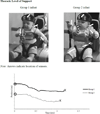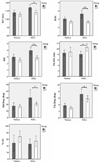Segmental trunk control acquisition and reaching in typically developing infants
- PMID: 23681292
- PMCID: PMC3773211
- DOI: 10.1007/s00221-013-3544-y
Segmental trunk control acquisition and reaching in typically developing infants
Abstract
This study explored the influence of an external support at the thoracic and pelvic level of the trunk on the success of reaching, postural stability and reaching kinematics while infants reached for a toy. Seventeen infants (4-6 months) were clustered into two groups according to their trunk control assessed with the Segmental Assessment of Trunk Control. Major differences were seen between groups with pelvic support, whereas with thoracic support, all infants showed similar quality reaching behaviors. With the external pelvic support, infants who had acquired trunk control in the lumbar region were more accurate in their reaching movements (less movement time, improved straightness of reach, less movement units and increased path length per movement unit) and were more stable (decreased trunk and head displacement) during a reach than infants who had only acquired trunk control in the thoracic region. These results support the hypothesis that trunk control influences the quality of reaching behavior.
Figures



Similar articles
-
Influence of Different Sitting Positions on Healthy Infants' Reaching Movements.J Mot Behav. 2017 Nov-Dec;49(6):603-610. doi: 10.1080/00222895.2016.1247034. Epub 2016 Dec 23. J Mot Behav. 2017. PMID: 28010676
-
Development of infant reaching behaviors: kinematic changes in touching and hitting.Infant Behav Dev. 2013 Dec;36(4):825-32. doi: 10.1016/j.infbeh.2013.09.009. Epub 2013 Oct 18. Infant Behav Dev. 2013. PMID: 24140840
-
Toy-oriented changes during early arm movements: hand kinematics.Infant Behav Dev. 2006 Jul;29(3):358-72. doi: 10.1016/j.infbeh.2006.01.005. Epub 2006 Mar 7. Infant Behav Dev. 2006. PMID: 17138291
-
Sit happens: Does sitting development perturb reaching development, or vice versa?Infant Behav Dev. 2013 Jun;36(3):438-50. doi: 10.1016/j.infbeh.2013.03.011. Epub 2013 May 2. Infant Behav Dev. 2013. PMID: 23644424
-
Infant Reaching in the First Year of Life: A Scoping Review of Typical Development and Examples of Atypical Development.Phys Occup Ther Pediatr. 2022;42(1):80-98. doi: 10.1080/01942638.2021.1921092. Epub 2021 May 11. Phys Occup Ther Pediatr. 2022. PMID: 33975491
Cited by
-
The development of trunk control and its relation to reaching in infancy: a longitudinal study.Front Hum Neurosci. 2015 Feb 24;9:94. doi: 10.3389/fnhum.2015.00094. eCollection 2015. Front Hum Neurosci. 2015. PMID: 25759646 Free PMC article.
-
Object interaction and walking: Integration of old and new skills in infant development.Infancy. 2019 Jul-Aug;24(4):547-569. doi: 10.1111/infa.12289. Epub 2019 Apr 7. Infancy. 2019. PMID: 31244556 Free PMC article.
-
Caregiver-reported newborn term and preterm motor abilities: psychometrics of the PediaTracTM Motor domain.Pediatr Res. 2023 May;93(6):1736-1744. doi: 10.1038/s41390-022-02312-4. Epub 2022 Sep 30. Pediatr Res. 2023. PMID: 36180587 Free PMC article.
-
Embedding Play to Enrich Physical Therapy.Behav Sci (Basel). 2023 May 24;13(6):440. doi: 10.3390/bs13060440. Behav Sci (Basel). 2023. PMID: 37366692 Free PMC article.
-
Mobility guidelines for the care of people with spina bifida.J Pediatr Rehabil Med. 2020;13(4):621-627. doi: 10.3233/PRM-200744. J Pediatr Rehabil Med. 2020. PMID: 33325411 Free PMC article. Review.
References
-
- Assaiante C. Development of locomotor balance control in healthy children. Neurosci Biobehav Rev. 1998;22(4):527–532. - PubMed
-
- Bayley N. Bayley Scales of Infant Development. New York: Oxford University Press; 1969.
-
- de Graaf-Peters VB, Bakker H, van Eykern LA, Otten B, Hadders-Algra M. Postural adjustments and reaching in 4- and 6- months-old infants: an EMG and kinematical study. Exp Brain Res. 2007;181:647–656. - PubMed
Publication types
MeSH terms
Grants and funding
LinkOut - more resources
Full Text Sources
Other Literature Sources
Medical

